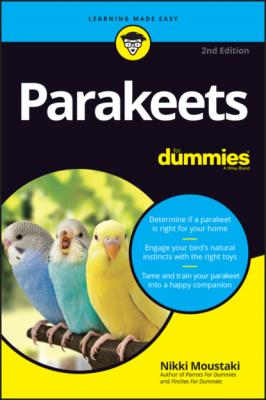ТОП просматриваемых книг сайта:
Parakeets For Dummies. Nikki Moustaki
Читать онлайн.Название Parakeets For Dummies
Год выпуска 0
isbn 9781119755302
Автор произведения Nikki Moustaki
Жанр Биология
Издательство John Wiley & Sons Limited
Chapter 2
Is a Parakeet Your Perfect Companion?
IN THIS CHAPTER
If you’re trying to decide whether to bring a parakeet into your home, you’ve come to the right chapter. Even if you already have a parakeet, this chapter has something for you too. Here you’ll figure out what to expect from a parakeet (from its bubbly personality to the dreaded messes it makes) and what your parakeet expects from you. I walk you through the challenges posed by children and companion animals (whether birds or cats or dogs). I also give you information on keeping more than one parakeet.
Knowing What to Expect from a Parakeet
As wonderful as they are, parakeets are still considered wild animals, just as are all companion parrots. Though parakeets are about as close as a bird comes to being domesticated (other than the canary), they still have their quirks. Knowing what to expect from your parakeet — from personality to lifespan — will make your relationship with your bird better and stronger.
A great personality
As with humans, each parakeet is an individual with its own individual personality. Some are sweet and affectionate, while others may always remain fearful or aggressive. What you receive from your parakeet depends a lot on what you put into it. In general, a kind, careful guardian can tame a parakeet into a loving companion.
If you buy two parakeets that look similar, you may worry that you’ll never be able to tell them apart. After you get to know them, you’ll see that they have personalities of their own, likes and dislikes, different mannerisms, and different aptitudes for talking and training.
Noise and talking ability
If you require an absolutely quiet home, then parakeets are not the bird for you. You’re never going to prevent noise. They chatter, sing, and even talk for a good part of the day, though they do have their quiet moments. Fortunately, parakeets aren’t loud, but they are persistently noisy. Just as beauty is in the eye of the beholder, loudness is in the ear of the hearer. Some people aren’t bothered at all by parakeet noise, while others may be annoyed by the constant chirruping.
Parakeets are excellent talkers. They can even out-talk some of the larger bird species. Parakeets can learn hundreds of words and phrases and say them clearly and interchangeably. Cocks (male birds) are more apt to talk earlier and more frequently, but hens (female birds) have been known to do their share of chatting as well.
Companionship
One of the best reasons to get a parakeet is for companionship. Parakeets are affectionate companions and bond readily to any human who is patient and kind. Your parakeet may love to stand on your shoulder while you do your chores or watch television. He’ll preen your eyebrows and sing into your ear.
Mess and more mess
Birds are messy. You’ll definitely be walking on a crunchy floor, and perhaps even a bit of water to go with it after the parakeet has taken its bath. You may even find seeds growing out of your carpet (yes, it has happened to me)!
A decade or more of life — if you take care of the bird
Unfortunately, most parakeets only live a few years in the average home due to improper care and feeding, neglect, and accidents. But with the proper care, a parakeet can live 12 to 15 years.
The larger English budgie, because of its specific breeding, tends to live to be only about 7 or 8 — and that’s an old English budgie. They may be able to live longer with exceptional care.
Knowing What Your Parakeet Expects from You
Your parakeet relies on you for all of its needs: proper housing, nutrition, playtime out of the cage, and safety. You’re responsible for every aspect of its life. In the following sections, I let you know what your parakeet needs from you, but here’s a short list of the basic things your parakeet needs:
A clean cage: You’ll need to clean the bottom of your parakeet’s cage nearly every day, or your bird’s waste will become crusty and turn into a fine dust, which your parakeet (and you) can inhale. This is not healthy. Once a week, clean the cage and the surrounding area more thoroughly. (More on how to clean the cage in Chapter 9.)
Water: Offer your parakeet fresh water twice a day if you can; at least once a day for sure. If the water dish isn’t empty (it shouldn’t be anyway), throw out the remainder of the dirty water and replace it so that your parakeet always has a fresh water supply.
Food: Provide and change fresh and cooked foods once a day. Just as with water, if your parakeet hasn’t eaten all the fresh or cooked foods you gave your bird the day before, throw out the old food and replace it with new. Uncooked foods like seeds or pellets can remain in the dish and you can just top them off. (Note: You should change the water twice a day if possible, but you need to change the food only once a day.)
Playtime: Your parakeet needs safe playtime out of the cage every day unless the bird is in a large flight cage at least three to four feet in length, or a larger aviary. Be sure to keep a close eye on your bird — and on your other pets — whenever your parakeet is out of its cage. Also, check your bird’s

